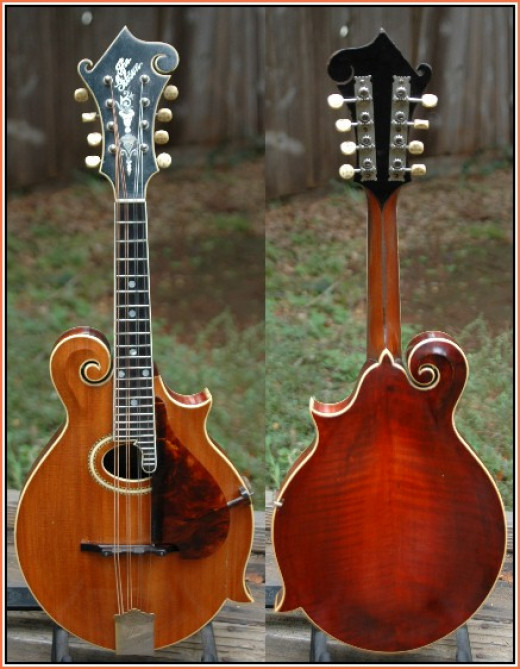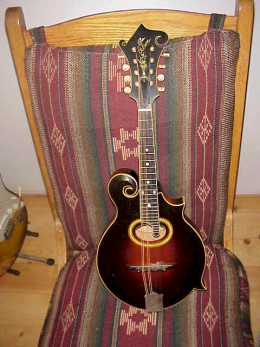A 1912 Gibson F-4 Mandolin

Source
The Gibson F-4 Mandolin.
Contrary
to what might be a common notion, the Gibson F-4 mandolin was not
designed by Lloyd Loar, the luthier that designed the more widely known
F-5, but rather, the F-4 was designed by Orville Gibson himself, the
founder of the great Gibson Guitar Company. The Gibson F-4 was radical,
and nothing quite like it had ever been seen before when it debuted on
the market in 1909 - it was the Gibson flagship instrument.
What was so radical about the Gibson F-4 mandolin? Well, just look at it. Before the Gibson F-4 was introduced to the world, mandolins just didn't look like that. Before the Gibson F-4, mandolins were basically a very plain looking instrument with an oval shaped body. They were so very plain looking that the pre Gibson F-4 mandolins of the world were often referred to simply as "taterbugs."
What was so radical about the Gibson F-4 mandolin? Well, just look at it. Before the Gibson F-4 was introduced to the world, mandolins just didn't look like that. Before the Gibson F-4, mandolins were basically a very plain looking instrument with an oval shaped body. They were so very plain looking that the pre Gibson F-4 mandolins of the world were often referred to simply as "taterbugs."
A 1921 Gibson F-4 Mandolin.

Source
Orville Gibson And Mandolin Innovation.
Orville
Gibson had studied Cremona violins, and he decided that his Gibson
mandolins should be made to mimic the Cremona violins, and indeed, be
even more beautiful to both the eye and the ear,if possible.Orville
Gibson wanted to create legendary instruments that would last in style
and in individual instruments - far beyond his lifetime, and that is
exactly what he managed to accomplish.
If you do not know, then the mandolin is a very similar instrument to the violin or "fiddle." The mandolin is only set up with eight strings in comparison to the violin's four strings. Playing the mandolin is only a thing different in that it is done with a pick instead of a bow, and thus the frets on the finger board, and also, rather than as with picking a guitar, the mandolin is set up for never hitting less than TWO strings at any given time with a plectrum.
Do you see all the intricate curves on these Gibson F-4 mandolins? Before this instrument was created, there was NOTHING remotely so intricate in the world of mandolins. The musicians of the mandolin surely fell for these instantly. Oh I'd suspect some folks couldn't take to the design at first, but you can bet that soon enough everyone that made mandolins took proper notice, and realized that their skills were going to have to improve vastly in order to compete with the wiles of Orville Gibson.
Shaping a tone wood into all these scrolls and sharp points in such a precision way as is clearly evident on the Gibson F-4 mandolin, that is no small matter, isn't done easily, and can't be expected to be had by any consumer for cheap, and neither should it be. This instrument is not only for making fine works of art, it is a work of art in and of itself.
Though the F-4 mandolin was the pride of Gibson after its debut, it was a special order instrument, and it was available from 1909 up until 1943. Initially the F-4 was finished in black, gold top finish was available, and towards the end of this fine masterwork's run, a deep red had become the standard finish. The tops or sound boards of these mandolins are, of course, carved spruce, but the back and sides of any specific one might be either maple, or birch.
Some of these instruments, should you ever be so fortunate as to touch one, may be signed by legendary luthier Lloyd Loar, but of course as stated above, Mr. Lloyd Loar, designer of the more common and still in production Gibson F-5 mandolin, did not design this. instrument,
Today both old time folk or bluegrass musicians and classical mandolin players both appreciate this work of art for the otherworldly sweet tone and, of course, its inherent beauty. Buckle up, if you wish to purchase one of these very rare mandolins, they aren't inexpensive, but when compared to the Lloyd Loar F-5s, are a bargain.
If you do not know, then the mandolin is a very similar instrument to the violin or "fiddle." The mandolin is only set up with eight strings in comparison to the violin's four strings. Playing the mandolin is only a thing different in that it is done with a pick instead of a bow, and thus the frets on the finger board, and also, rather than as with picking a guitar, the mandolin is set up for never hitting less than TWO strings at any given time with a plectrum.
Do you see all the intricate curves on these Gibson F-4 mandolins? Before this instrument was created, there was NOTHING remotely so intricate in the world of mandolins. The musicians of the mandolin surely fell for these instantly. Oh I'd suspect some folks couldn't take to the design at first, but you can bet that soon enough everyone that made mandolins took proper notice, and realized that their skills were going to have to improve vastly in order to compete with the wiles of Orville Gibson.
Shaping a tone wood into all these scrolls and sharp points in such a precision way as is clearly evident on the Gibson F-4 mandolin, that is no small matter, isn't done easily, and can't be expected to be had by any consumer for cheap, and neither should it be. This instrument is not only for making fine works of art, it is a work of art in and of itself.
Though the F-4 mandolin was the pride of Gibson after its debut, it was a special order instrument, and it was available from 1909 up until 1943. Initially the F-4 was finished in black, gold top finish was available, and towards the end of this fine masterwork's run, a deep red had become the standard finish. The tops or sound boards of these mandolins are, of course, carved spruce, but the back and sides of any specific one might be either maple, or birch.
Some of these instruments, should you ever be so fortunate as to touch one, may be signed by legendary luthier Lloyd Loar, but of course as stated above, Mr. Lloyd Loar, designer of the more common and still in production Gibson F-5 mandolin, did not design this. instrument,
Today both old time folk or bluegrass musicians and classical mandolin players both appreciate this work of art for the otherworldly sweet tone and, of course, its inherent beauty. Buckle up, if you wish to purchase one of these very rare mandolins, they aren't inexpensive, but when compared to the Lloyd Loar F-5s, are a bargain.


 11:52 PM
11:52 PM
 Wesman Todd Shaw
Wesman Todd Shaw

0 comments:
Post a Comment